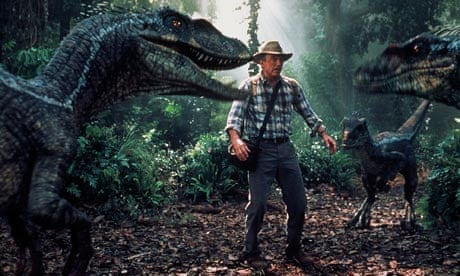No film has influenced popular understanding of dinosaurs more than Jurassic Park. Based on the 1990 novel by the late Michael Crichton, Steven Spielberg's Oscar-winning epic three years later envisaged an amusement park stocked with dinosaurs brought back to life by the wonders of genetic cloning.
In the process, stars were made of a host of dinosaurs. Fifteen different species appeared in the first novel (Crichton published a sequel in 1995), including old favourites such as T. rex, Stegosaurus and Triceratops, plus less well known species including Maiasaura and Dilophosaurus (the majority of these dinosaurs lived in the Cretaceous period, despite the story's title).
But the dinosaur which gained the biggest publicity boost from Spielberg's film was Velociraptor, a Late Cretaceous theropod first discovered in the Gobi desert in 1922. However, the fearsome impression people have of it now does not tally with reality.
Known simply as "raptors" in the film, Velociraptor was portrayed as a person-sized, terrifyingly fast and vicious predator that tormented the unfortunate Sam Neill and his Hollywood co-stars. A star was born (Velociraptor, not Neill) - but the portrayal was inaccurate, both in terms of size (in reality, Velociraptor stood barely half a metre high), and its lack of feathers ("quill knobs" proving that Velociraptor was feathered were overlooked until 2007 when they were discovered on the forelimb).
Size-wise, and in terms of its large sickle-shaped talons on each foot, the dinosaur in the film is more like Velociraptor's larger dromaeosaurid cousin, Deinonychus (although it too was a feathered theropod).
It is speculated that this incorrect portrayal came about because of mislabelling of Deinonychus as a subspecies of Velociraptor in the 1988 American book, Predatory Dinosaurs of the World, whose author, Gregory Paul, is credited as an inspiration by Crichton at the end of his first novel.
Other inaccuracies in the first film include the giant sauropod Brachiosaurus being given a whale-like call (there is no evidence of it having been able to make any kind of call), standing on its hind legs to reach food and then chewing it. Dilophosaurus was also shrunken significantly and given an imaginary ability to spit poison.
The third part of the Jurassic Park trilogy (directed by Spielberg's friend Joe Johnston) made a star of the large sail-backed carnivore Spinosaurus, which is shown fighting with and killing a T. rex. This again caused a furore among dinosaur followers: Spinosaurus's long, thin snout is likely to have evolved for feeding on fish - and it has only been found in Egypt and possibly Morocco, whereas T. rex specimens have only been found in North America. Furthermore, Spinosaurus is thought to have lived around 100-93m years ago, while T. rex lived 68-65m years ago.
Did you know?
The animatronic T. rex that starred in Jurassic Park was 6 metres high, 12 metres long and weighed close to 6 tonnes. According to the famous American palaeontologist Jack Horner, who was the film's technical adviser, it was "the closest I've ever been to a live dinosaur". The T. rex's roar was reportedly a composite of the roars of a tiger, alligator and baby elephant ...
